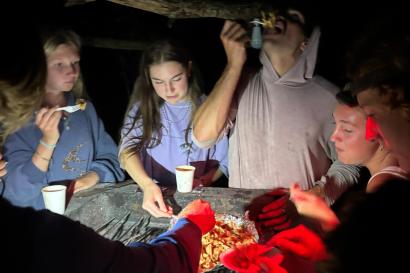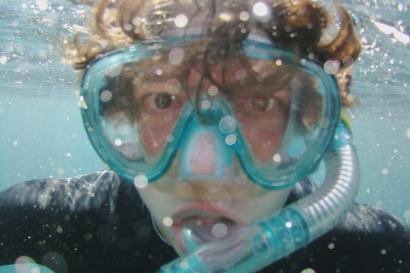There are many exotic and invasive species to be found in the Galapagos Islands, but the Eastern moose is not one of them. Nor is the black bear, the fox, the porcupine, or any other wild mammal that you might run into on a walk in a Northern forest. It’s still strange, after years of being on the lookout for large mammals while running on trails in the Maine woods, to hop along the lava rocks here and know that I’m not likely to run into anything larger than a marine iguana (not that a two-foot long lichen-covered male is anything to scoff at). I suppose I could run into a feral goat, but that prospect doesn’t quite have the same allure as a white-tailed deer bounding across the trail, or a lone coyote watching from the edge of an overgrown field. As you might expect, though, these island paths hold different wonders: tiny lava lizards doing push-ups during a courting display, frigatebirds flying overhead with red throat pouches swinging, blue-footed boobies diving into the sea like arrows.
You might be asking yourself, too, “What about the tortoises? The giant ones that Darwin rode like ponies as they ambled down the sides of volcanoes? Aren’t those big enough?” Unfortunately, those iconic giants aren’t nearly as easy to find as they were in 1835. In San Cristobal, where they once roamed throughout the entire island, hunting and human encroachment have restricted the island’s population to a tiny portion of the highlands, where there is now a tortoise breeding center.
Though I could never expect to happen upon a tortoise on a run in San Cristobal, a day in the highlands of Santa Cruz revealed these reptilian giants in their natural habitat. Our Medical Anthropology class brought us to our neighboring island for a week, and one day we drove up to the highlands to visit a tortoise reserve.
Driving away from the sea, a bit of altitude brings taller and thicker vegetation. Brown moss hangs off branches and I marvel at the height of the ceiba trees, which seem remarkably tall on an island where cacti are often the best source of shade. We walked along a trail until we came to a pair of tortoises mating in slow-motion. I could hear them breathing through their nostrils, which were perfectly round like the holes in a wrinkly coconut or a leathery bowling ball. The male was mounting his partner, grasping her shell with huge, scaly dinosaur hands, his claws scraping down its sides. He must have weighed six hundred pounds. Nearby, a third tortoise chewed a guava fruit’s pink insides with a toothless beak.
We walked on and entered the closest thing to “woods” I’ve experienced in months. There was actual continuous shade, and we were surrounded by green. I fell back behind the rest of the group and was enjoying the smell of soil when I heard a rustling of leaves and snapping of branches off the side of the trail. I squinted through the light green foliage and spotted an ancient-looking tortoise lumbering along through the undergrowth. For the hundredth time this semester, I felt like I was walking on a different planet, there among the old giants and their guava trees. It made me so happy to know that they’re still out there, wandering through the highlands, an example of the endemic life which makes this protected archipelago, the cradle of evolution, so special. I considered hopping onto the tortoise’s back to try out Darwin’s old hobby, but I figured that was probably highly frowned upon in these National Park lands, and seeing it there by the trailside, watching it walk slowly along like it has for perhaps a century, was enough.


Grace Glynn
<p><span style="color: rgb(29, 29, 29); font-family: Arial, Verdana, sans-serif; font-size: 12px; line-height: normal; background-color: rgb(237, 237, 237);">Grace is a junior at Connecticut College with a major in botany. She grew up on the coast of Maine and looks forward to leaving its harsh winter for the equatorial Galapagos Islands. Grace’s interests include paleontology, backpacking, folk music, and fermented foods. Join her as she heads to Ecuador for the semester!</span></p>






